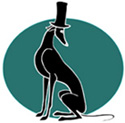

|
You will want to have all the items you need for your new dog before he comes home. Crate, bedding, food, bowls, toys, a large dog nail trimmer, styptic powder, grooming mitt, shampoo, and first aid supplies. You will want to get a good pet odor and stain remover, too; It is good to have on hand for any accidents. If you can remove the odor, they are less likely to repeat it! We recommend that you purchase a crate for your dog unless you adopt a dog that has been fostered and no longer needs or wants one. The crate will not only keep your hound out of trouble, it is the only thing familiar to your hound when it walks into your home. You will want to have at least a 48" deep crate for your dog, no matter what their size. The crates at the track are actually 52" deep, so this is the size your dog is accustomed to. We recommend that the crate be placed in the room where you spend the most time, since this will become your hound's comfort zone. If you are using a crate that collapses make sure the top, sides and bottom tray have been secured with zip ties or clips so the dog can not pull the crate down on top of himself if he tries to escape. It is also a good idea to put extra clips on the door. Greyhounds need something soft to sleep on because they have so little body fat. Large, soft beds are their favorites and many will “nest” in them (pull on them with their feet) to get it just right. We recommend that you use some old comforters (you can purchase great ones at the thrift store) until you know if your dog has a tendency to shred bedding. You certainly don't want to find out you have a shredder when your dog shreds a brand new $50 dog bed. Depending on the time of year you adopt, you may also want to get a good, lightweight coat for winter and cool fall and spring mornings. You will want to get one made for greyhounds to cover their deep chests and long backs. A raised food bowl can make dinner more enjoyable for your long legged friend. Greyhounds really have to contort themselves to eat from floor level. We recommend that they stand 14-18” off the floor, depending on your dog’s height. A large, raised water bowl is also a good idea since greyhounds drink a lot. Our adopters have shown us some innovative and inexpensive methods of raising their dog's bowls, with a favorite being plant stands purchased at home improvement stores. Have a couple of sturdy chew toys in case your Grey wants to chew on something inappropriate – substitute the toy quickly for the inappropriate object. You should not allow them to chew on consumable things like rawhides when you are not home to supervise. These can be a choking hazard and ingesting large pieces can cause obstruction. Give your dog something sturdier, like a frozen peanut butter stuffed Kong, when you are away.
Go around your house as if you were bringing a toddler into your home:
Try to schedule your adoption when you can take a few days off – even it is just a weekend. It really helps with bonding and helping the dog feel less afraid and abandoned in a strange environment. It also allows you to confirm housebreaking and begin alone training. |
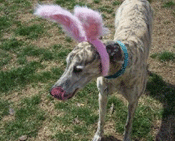

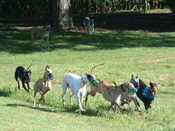
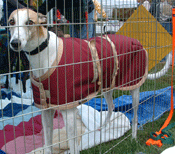
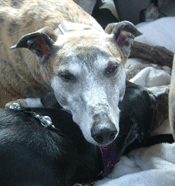
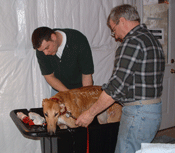
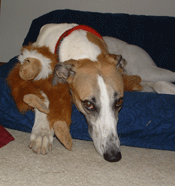
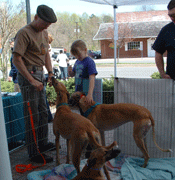
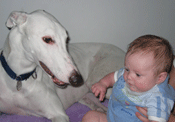
|
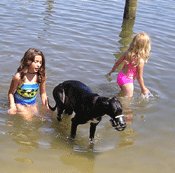
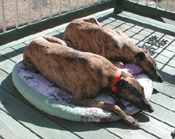

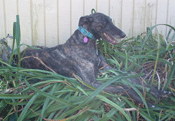
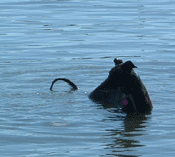
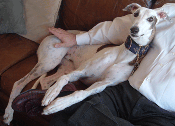
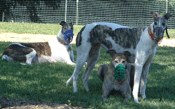
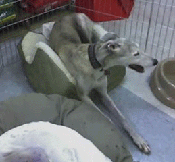
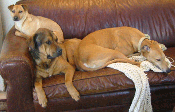
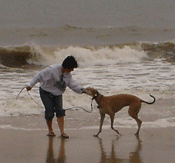
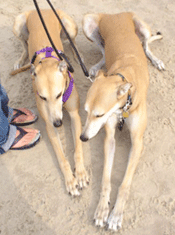
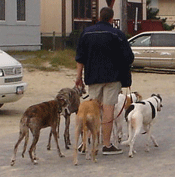
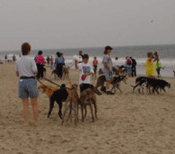
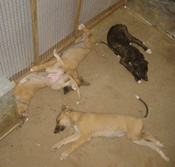
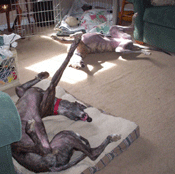
|
Introduce your new Grey to any other pets while muzzled and on lead just to be safe. Don't leave your Grey alone with any pet until they have settled in (this may be weeks or months). Remember that a running cat can elicit a different response from your Grey so be on top of them during introductions and after. Introduce your pup to the house and yard. Keep them with you (using a leash in the house) to avoid ‘stress’ potty accidents. Let them out to potty frequently, especially first and last thing of the day and after meals. Praise them when they go! Use words like ‘Go Potty’ when they relieve themselves and soon they will know to go on command – very helpful when traveling. If you don’t have a fenced in yard, they may be shy at first to potty on lead. Using a longer lead and ignoring the dog may help them through this process. Use the crate whenever you can’t be right with them. . This is for the dog’s safety and security, your home’s safety, other pet’s and your children’s safety. Let them have quiet time in the crate to adjust to their new environment. Your Grey will not want to sleep alone at night - greyhounds are pack animals and want to be with you during the night and when you are home. Keeping them apart will cause them to cry and will create separation anxiety. Do not sleep on the couch next to your dog's crate to keep him quiet that first night, either - your dog will quickly expect you to sleep there every night and will escalate his crying and whining exponentially. Instead, move your dog to your room with you. At first, you may want them to be in the crate IN your room, slowly getting them to the point that they are happy with free roam of your room at night. A babygate in the doorway can keep your dog from wandering around the entire house at night. Two good tips for bonding with your new dog: Massage your new dog – paying particular attention to the area down the back on either side of the spine. They love massaging and you can combine it with mitt brushing if you want. The main thing is to show them that touch from you is a good thing. Coo to them while massaging them. Go with the grain of the hair. The second tip is: feed them while holding their food bowl in your lap with you sitting on the floor. This teaches them that the most important thing in their lives comes from you. It also helps them adjust to being touched and near people while eating. You may have to start slowly with the bowl beside you, and work up to holding the bowl while they eat. It's very important that you start teaching your dog it is OK for you to leave the house without him right away. Make sure that you give your dog some time alone the first day he arrives in your home. Don't give your dog access to the entire house right away, this can also cause anxiety. Practice alone training using your crate or by baby gating your dog into a smaller room (preferably the living room or kitchen; a room your dog is accustomed to). If your Grey seems upset when you leave, leave a radio on or use a Canine Lullabies CD, or through a Dog’s Ear to help them adjust. Start with very short alone sessions and slowly build your dog up based on his tolerance level. The book Retired Racing Greyhounds for Dummies has an excellent, step-by-step guide to alone training and your adoption buddy can help you as well. Be consistent from the beginning with your house rules for your Grey. This means from the first moment they are in your house; do not "let things go" the first day or week because you feel sorry for your dog. Your dog will feel more secure if it knows where it stands right from day one. Keep a water spray bottle or squirt pistol handy so you can correct any unacceptable behavior. After one or two squirts, all you will have to do is hold the bottle up and they will know. This is helpful also because you can respond from a distance. Be reassuring and catch them being good as well. They love cooing and praise in a happy and light voice. As with all training, timing is everything. Correcting or praising a behavior after it has happened means nothing to your dog - you must act while the behavior is occuring. Don’t be surprised if your Grey smiles at you – it looks like a sneer so don’t be frightened by it. Also, some Greys when happy and excited may ‘nit’- small little chewing movements against your arm, nipping, or putting their mouth on your arm. They aren’t trying to hurt you but just showing their happiness. A gentle correction can curb any inappropriate enthusiasm. Be prepared to have your dog hoard items. Greyhounds have never had things of their own and their bedding up until this point was shredded paper. They are especially fond of pillows, stuffed animals, and blankets. They may take these into their crate or just bring them to the room you spend most time in. It is quite cute actually. It is good to have some special soft things just for them to cuddle with. A good walk or romp in the yard each day would help relieve stress during this new time – for both of you! Greyhounds love to smell and check out new situations. They are so curious! Also, a tired dog is a good dog - if your dog is getting into everything, it probably needs more exercise and stimulation. Greyhounds are intelligent dogs and benefit from new experiences and having ‘jobs’ to do to keep them happy and healthy. A job could be walking with you to the mailbox every day, riding to the trash dump, going with you to feed other animals, riding with you to pick up the kids, and such. An obedience class can be wonderful, help you bond, and be lots of fun for both your dog and you. Don’t have all your friends and neighbors come over the first day if you can help it. In fact, do your best not to smother your new dog with attention. The dog will have all it can do to become accustomed to you, your home, and family. Watch for your dog’s signals and judge when they are overwhelmed and make sure they have down time. Once your dog understands your routine and seems settled (usually a week or so), then you can invite the friends, family, and neighbors over for a "retirement" party. Also, start exposing them to other social situations (PetSmart, Parks, etc). The more you introduce them to, the happier and more social they will be. |